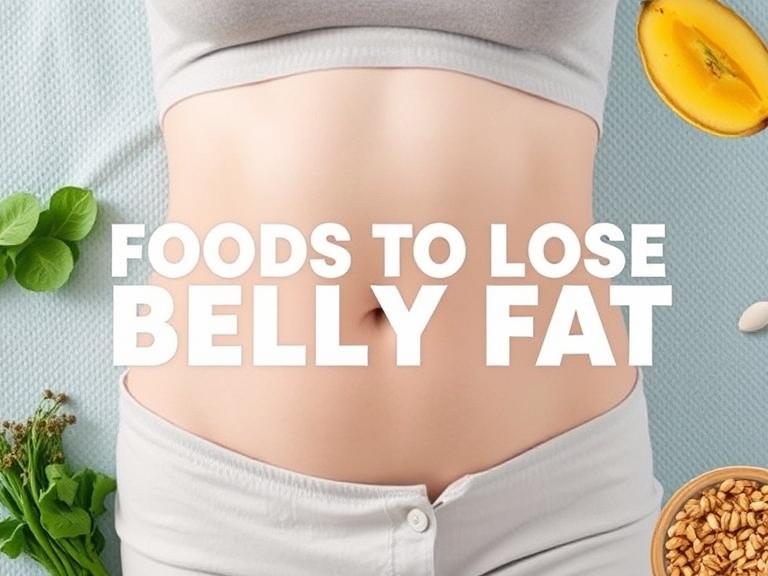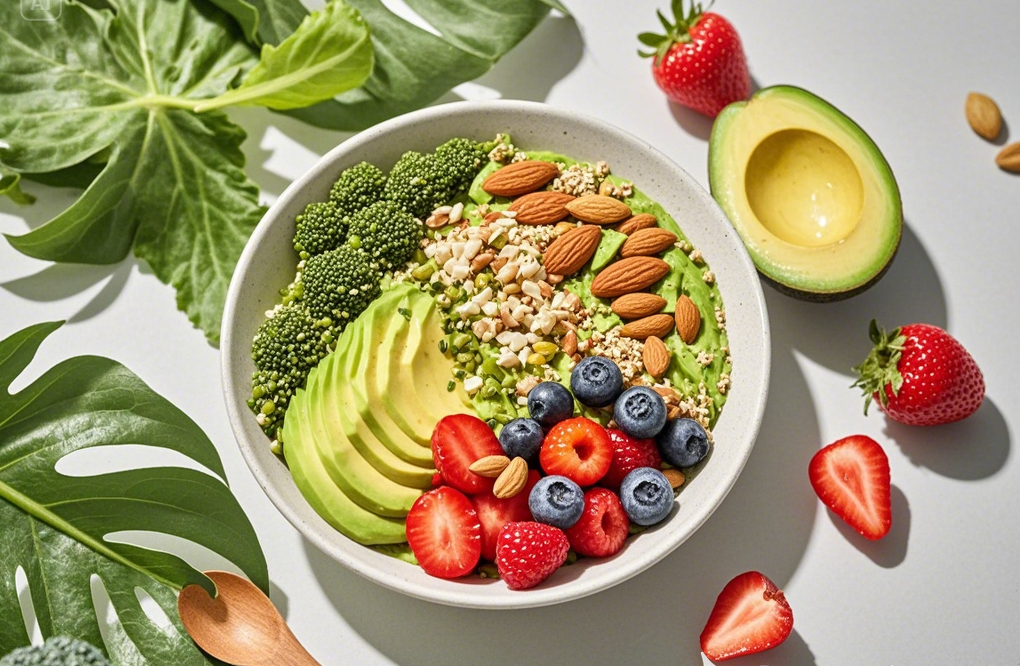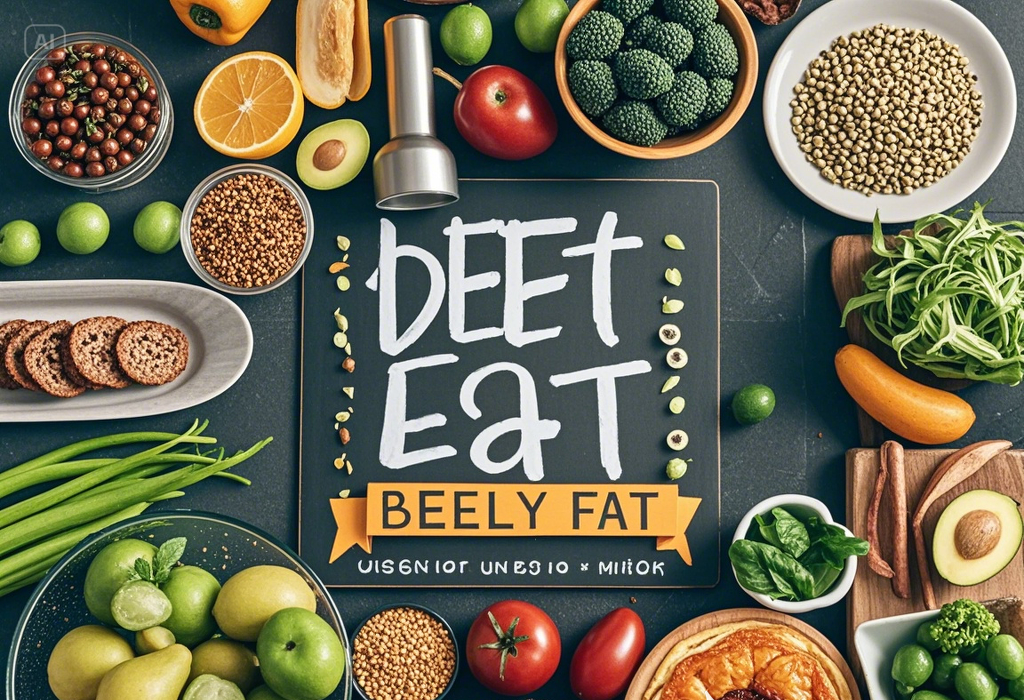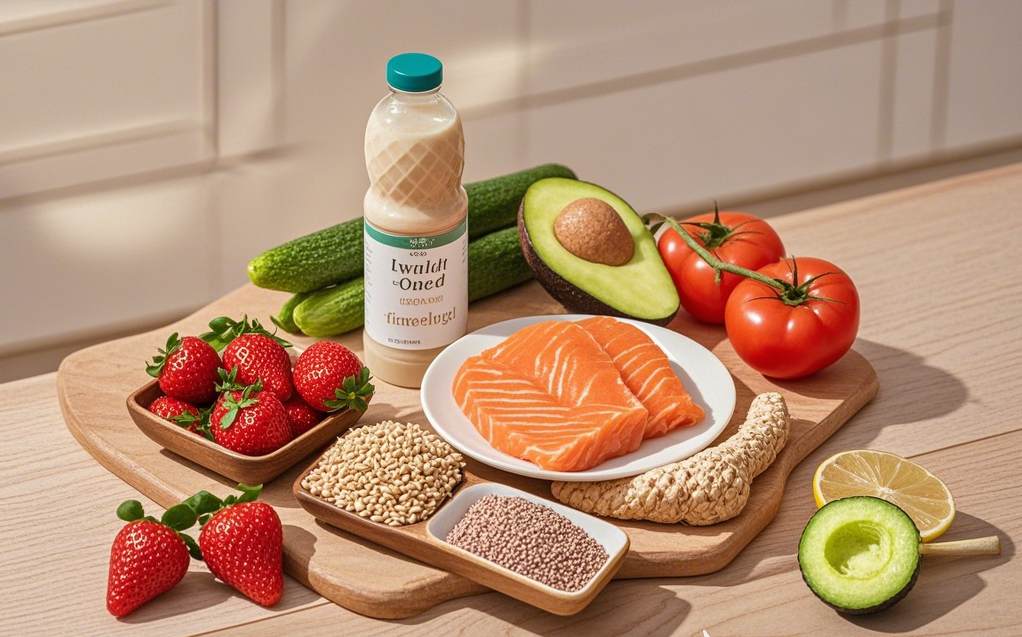Losing belly fat isn’t just about looking good—it’s crucial for your health. Belly fat, particularly visceral fat, surrounds your internal organs and is linked to serious health problems, including heart disease, diabetes, and liver disease. This guide will walk you through science-backed food choices and strategies to help you shed belly fat effectively and sustainably.
Part 1: Understanding Belly Fat and Its Causes

Belly fat, often referred to as visceral fat, has become a topic of growing concern in modern society. While a certain amount of fat is essential for keenness, energy storage, and protection of internal organs, an excess accumulation around the abdomen can pose significant health risks. Understanding the nuances of belly fat involves not just recognizing its presence, but delving into the multifaceted causes that contribute to its development.
At the fundamental level, belly fat results from an energy imbalance, where the calories consumed from food exceed the calories expended through physical activity and metabolic processes. However, this straightforward explanation only scratches the surface, as a myriad of factors interplay to influence this balance.
Dietary Choices
Nutrition plays a pivotal role in the management of body fat. Diets high in processed foods, refined sugars, and unhealthy fats can lead to increased fat accumulation, particularly in the abdomen. Sugary beverages, in particular, have been linked to weight gain and the expansion of visceral fat. Conversely, a diet rich in whole foods, including fruits, vegetables, lean proteins, and healthy fats, can help mitigate these risks and promote overall health.
Lack of Physical Activity
In today’s increasingly sedentary lifestyle, the importance of regular physical activity cannot be overstated. When the body is not engaged in movement, the likelihood of excess calories being stored as fat rises considerably. Regular aerobic exercise, strength training, and activities that promote overall fitness are essential not just for weight management, but for enhancing metabolic function and reducing the risks associated with belly fat.
Genetics and Hormones
Genetics also play a role in how and where our bodies store fat. Some individuals may be genetically predisposed to accumulate fat in the abdominal area. Hormones further complicate this picture; factors such as stress can lead to elevated levels of cortisol, a hormone associated with fat storage in the midsection. Additionally, hormonal changes, particularly during menopause for women, can trigger shifts in how fat is stored and distributed.
Stress and Sleep
Psychological factors such as stress and inadequate sleep may also contribute to increased belly fat. When under stress, the body produces cortisol, which not only stimulates appetite but can also lead to cravings for high-calorie comfort foods. Moreover, sleep deprivation disrupts the body’s hormonal balance, leading to an increase in hunger hormones while reducing those that signal fullness, creating a perfect storm for weight gain.
Age
As individuals age, their metabolism naturally slows, which can further exacerbate weight gain if dietary habits and activity levels don’t adjust accordingly. Muscle mass tends to decrease with age, and since lean muscle burns more calories than fat, this decline can contribute to increased belly fat accumulation if countermeasures, such as strength training, are not employed.
1.1 What is Belly Fat and Why is it Dangerous?

Belly fat consists of two types:
- Subcutaneous fat: Found just beneath the skin, this fat is less harmful but still impacts your overall fitness.
- Visceral fat: Surrounds internal organs and is associated with metabolic disorders, inflammation, and increased risk of chronic illnesses.
A study published in The Lancet highlights that excess visceral fat significantly raises the risk of cardiovascular diseases even in individuals with a normal BMI.
1.2 Causes of Belly Fat Accumulation
- Unhealthy Diet: High-calorie, low-nutrient foods like sugary drinks, fried snacks, and processed carbohydrates lead to fat storage.
- Sedentary Lifestyle: Lack of physical activity reduces calorie burn and promotes fat accumulation.
- Stress: Elevated cortisol levels trigger fat storage in the abdominal area.
- Hormonal Imbalances: Disorders like hypothyroidism and PCOS can contribute to weight gain.
- Medications: Steroids and antidepressants may lead to abdominal fat gain as a side effect.
Part 2: Foods to Lose Belly Fat

Losing belly fat often involves a multifaceted approach to nutrition and lifestyle, and the foods you consume play a crucial role in this journey. While there’s no magic food that instantly melts away belly fat, certain diet choices can significantly promote weight loss, boost metabolism, and support overall health. Here’s a look at some of the best foods to incorporate into your diet for targeting belly fat.
1. Leafy Greens: Vegetables like spinach, kale, and Swiss chard are high in fiber and low in calories, making them an ideal choice for weight loss. Their high nutrient density helps to keep you feeling full, while their rich vitamin and mineral content supports overall health.
2. Lean Proteins: Foods such as chicken breast, turkey, fish, tofu, and legumes not only provide essential nutrients but also help rebuild muscle and promote satiety. Protein has a thermogenic effect, meaning the body burns more calories digesting it than it does for fats and carbohydrates. This can be especially helpful for those seeking to reduce belly fat.
3. Whole Grains: Oats, quinoa, brown rice, and whole grain bread are excellent sources of complex carbohydrates that are high in fiber. Fiber helps maintain steady blood sugar levels, reducing cravings and contributing to a feeling of fullness. Unlike refined grains, whole grains have not stripped away their nutrients, making them a healthier option.
4. Avocado: This creamy fruit is packed with healthy monounsaturated fats, which can help you feel full longer and reduce cravings. Avocados are also a great source of fiber and important vitamins, making them a fantastic addition to salads or smoothies.
5. Berries: Blueberries, strawberries, raspberries, and blackberries are rich in antioxidants and fiber while being relatively low in sugar. Their natural sweetness and vibrant flavors can satisfy your sweet tooth without sabotaging your diet, while their high fiber content aids digestion and helps regulate appetite.
6. Nuts and Seeds: Almonds, walnuts, chia seeds, and flaxseeds are nutrient-dense foods that contain healthy fats, protein, and fiber. A small handful can be great for snacking and can help prevent those unhealthy cravings. However, moderation is key, as they are calorie-dense.
7. Greek Yogurt: This dairy product is rich in protein and probiotics. The live cultures can aid in digestion and help maintain a healthy gut microbiome, which is increasingly linked to weight management. Opt for unsweetened varieties to avoid added sugars.
8. Green Tea: Known for its metabolism-boosting properties, green tea is rich in antioxidants called catechins, which may help enhance fat burning, particularly during exercise. Sipping on green tea throughout the day can be a hydrating way to support your waistline goals.
9. Spices: Certain spices, such as cayenne pepper, cinnamon, and turmeric can enhance flavor without adding calories. They may also possess metabolic benefits; for instance, cayenne may increase metabolic rate and enhance fat oxidation.
In addition to these foods, it is vital to maintain a balanced diet and engage in regular physical activity. Remember that sustainable weight loss is a gradual process. Focus on making healthier choices and creating a calorie deficit, while also being mindful of portion sizes. Patience, persistence, and a commitment to lifestyle changes will ultimately lead to the results you seek. Combining these nutritional strategies with hydration and stress management will pave the way for a healthier, more vibrant you, with a reduction in belly fat.
2.1 Fiber-Rich Foods
Dietary fiber slows digestion, reduces hunger, and prevents fat storage.
- Leafy Greens: Spinach and kale are low-calorie but nutrient-rich.
- Fruits: Apples, pears, and avocados are packed with soluble fiber.
- Nuts and Seeds: Almonds, walnuts, chia seeds, and flaxseeds support weight management.
A study from The American Journal of Clinical Nutrition found that increasing fiber intake by 10 grams daily reduced visceral fat by 3.7% over five years.
2.2 Protein-Rich Foods
Protein boosts metabolism and preserves muscle mass during weight loss.
- Lean Meat: Chicken breast, turkey, and fish like salmon are excellent sources.
- Eggs: High in protein and promote satiety.
- Legumes: Lentils, black beans, and chickpeas provide plant-based protein.
2.3 Foods that Aid Digestion
Improving gut health can reduce bloating and aid fat loss.
- Yogurt: Contains probiotics for a healthy gut microbiome.
- Fermented Foods: Kimchi, sauerkraut, and pickles improve digestion.
2.4 Foods that Burn Fat
Certain foods stimulate thermogenesis, helping you burn more calories.
- Green Tea: Rich in catechins, which promote fat oxidation.
- Chili Peppers: Capsaicin boosts metabolism.
- Ginger: Improves digestion and metabolic rate.
2.5 Foods for Prolonged Fullness
- Oatmeal: A slow-digesting carb that keeps you full for hours.
- Soups and Salads: Low-calorie but high-volume options prevent overeating.
Part 3: Effective Meal Planning

3.1 Key Principles
- Eat Smaller, Frequent Meals: Stabilizes blood sugar and curbs overeating.
- Stay Hydrated: Drinking water before meals reduces calorie intake.
- Avoid Sugary Drinks: Opt for water, green tea, or black coffee.
3.2 Sample One-Day Meal Plan
- Breakfast: Oatmeal topped with fresh berries and a handful of almonds.
- Lunch: Grilled chicken salad with mixed greens, avocado, and olive oil dressing.
- Dinner: Baked salmon with steamed broccoli and quinoa.
- Snacks: Greek yogurt with chia seeds or a banana.
3.3 Tips for Success
- Adjust portion sizes based on your activity level.
- Experiment with different foods to prevent boredom.
- Combine with regular exercise for optimal results.
Effective meal planning is an essential strategy for promoting healthy eating habits and improving overall wellness. It combines elements of nutrition science with practical behavioral strategies, offering a structured approach to food preparation and consumption that can yield numerous health benefits.
The Importance of Meal Planning

Research has demonstrated that meal planning can lead to healthier dietary choices and improved nutrient intake. A study published in the journal “Public Health Nutrition” found that individuals who regularly plan their meals tend to consume more fruits, vegetables, and whole grains compared to those who do not engage in meal planning (Gibson & Conners, 2019). This increased intake of nutrient-dense foods is associated with a lower risk of chronic diseases, such as obesity, diabetes, and cardiovascular issues.
Psychological Factors in Meal Planning
Meal planning also addresses behavioral and psychological components of eating. The paradox of choice suggests that having too many options can lead to decision fatigue, which in turn can result in unhealthy food choices (Schwartz, 2004). By planning meals in advance, individuals can reduce the cognitive load associated with daily food decisions, making it easier to choose healthy options consistently.
Moreover, a study in the “International Journal of Behavioral Nutrition and Physical Activity” highlighted that meal planning can foster a sense of control and intentionality over one’s diet, which has been linked to more stable eating patterns and a greater likelihood of achieving nutritional goals (Rogers et al., 2020). This psychological empowerment can be a significant factor in sustaining long-term dietary changes.
Practical Strategies for Effective Meal Planning

- Set Clear Goals: Effective meal planning begins with clear, achievable goals. Whether the aim is weight loss, improved nutrition, or managing a health condition, setting specific targets helps to tailor the meal plan accordingly.
- Create a Weekly Menu: Dedicate time each week to plan meals. A structured approach, such as creating a weekly menu, can streamline shopping and cooking processes. Research shows that individuals who plan their meals tend to stick to healthier diets (Drewnowski et al., 2016).
- Incorporate Variety: A diverse diet is crucial for obtaining a range of nutrients. When planning meals, aim to include a variety of food groups—lean proteins, whole grains, healthy fats, and plenty of fruits and vegetables. As underscored by the Dietary Guidelines for Americans, a varied diet not only meets nutritional needs but also makes meals more enjoyable.
- Batch Cooking: Preparing meals in larger quantities and freezing portions for later use can save time and reduce the temptation to opt for unhealthy convenience foods. Studies have shown that those who engage in batch cooking tend to save money and minimize food waste as well (Liu et al., 2021).
- Stay Organized: Keeping an organized grocery list based on your meal plan helps to prevent impulse buys and ensures that you have all the ingredients on hand. This strategy minimizes the likelihood of resorting to fast food or unhealthy snacks due to lack of preparation.
- Mindful Eating: Finally, meal planning offers a valuable opportunity for mindful eating practices. Taking the time to enjoy meals, savor flavors, and listen to one’s hunger and satiety cues can improve the overall eating experience and foster healthier relationships with food.
Effective meal planning is a powerful tool for fostering healthier eating habits and enhancing overall well-being. By creating structured meal plans that emphasize diversity, organization, and mindful eating, individuals can improve their nutritional intake and make sustainable, positive changes in their diets. Evidence-based practices reinforce the benefits of meal planning, positioning it as an actionable strategy for health promotion in our increasingly fast-paced lives. By investing time and effort in planning meals, one can lay the foundation for a healthier lifestyle.
References
- Drewnowski, A., Almiron-Roig, E., & Ahuja, A. (2016). The Health Impact of Planned Meals. International Journal of Behavioral Nutrition and Physical Activity, 13, 101.
- Gibson, S., & Conners, M. (2019). The Role of Meal Planning in Healthy Eating. Public Health Nutrition, 22(2), 309-318.
- Liu, J., & Holbrook, B. (2021). Batch Cooking as an Affordable Strategy to Promote Healthy Eating. Nutrients, 13(8), 2965.
- Rogers, P. J., et al. (2020). Behavioral Strategies in Meal Planning: Are They Effective? International Journal of Behavioral Nutrition and Physical Activity, 17, 54.
- Schwartz, B. (2004). The Paradox of Choice: Why More is Less. HarperCollins
Part 4: Foods and Habits to Avoid

When it comes to maintaining optimal health and well-being, both dietary choices and lifestyle habits play a crucial role. Scientific evidence has shown that certain foods and habits can have detrimental effects on our health. Below, we explore several of these foods and habits that are best avoided.
1. Processed Foods
Highly processed foods, which often contain artificial ingredients, preservatives, and excessive amounts of sugar and salt, are prevalent in modern diets. Research indicates that these foods can contribute to a range of health issues, including obesity, diabetes, and cardiovascular disease. A study published in The BMJ found that increased consumption of ultra-processed foods is associated with a higher risk of all-cause mortality. This is likely due to their low nutritional value and high caloric density, leading individuals to consume more calories without essential nutrients.
2. Added Sugars
Diets high in added sugars—especially from sources like sugary beverages, candies, and baked goods—have been linked to obesity, type 2 diabetes, and heart disease. According to the American Heart Association (AHA), excessive sugar intake can lead to increased levels of triglycerides and lower levels of high-density lipoprotein (HDL) cholesterol, both of which are risk factors for heart disease. The World Health Organization (WHO) recommends that added sugars should make up less than 10% of total daily caloric intake, ideally even less for additional health benefits.
3. Trans Fats
Trans fats, often found in partially hydrogenated oils, are notorious for their negative impact on heart health. Studies have shown that these artificial fats can raise low-density lipoprotein (LDL) cholesterol levels while lowering HDL cholesterol levels. A review published in the New England Journal of Medicine highlighted that the consumption of trans fats is strongly correlated with an increased risk of coronary heart disease. As a result, many health organizations encourage the elimination of trans fats from diets altogether.
4. Red and Processed Meats
While protein is an essential component of a balanced diet, high consumption of red and processed meats has been associated with various health risks. Research published in the journal Circulation indicated that higher intake of processed meats is linked to an increased risk of heart disease, type 2 diabetes, and certain cancers. The World Health Organization classified processed meats as a Group 1 carcinogen, meaning there is sufficient evidence to suggest that they can contribute to the development of cancer, particularly colorectal cancer.
5. Excessive Alcohol Consumption
While moderate alcohol consumption may have certain cardiovascular benefits, excessive drinking poses significant health risks. The Centers for Disease Control and Prevention (CDC) defines heavy drinking as consuming eight or more drinks per week for women and 15 or more for men. Chronic excessive alcohol intake can lead to liver disease, certain cancers, and mental health issues. The National Institute on Alcohol Abuse and Alcoholism asserts that heavy drinking can also impair judgment and increase the risk of accidents and injuries.
6. Sedentary Lifestyle
In addition to unhealthy dietary choices, a sedentary lifestyle is another critical factor that can adversely affect health. Lack of physical activity is associated with obesity, cardiovascular disease, and decreased mental health. The World Health Organization recommends at least 150 minutes of moderate-intensity aerobic activity per week for adults. Long periods of inactivity can increase the risk of metabolic syndrome, a cluster of conditions that raise the risk for heart disease and diabetes.
Part 5: Pairing Diet with Exercise
Pairing diet with exercise is essential for optimizing health and achieving fitness goals. Scientific evidence supports the notion that the synergy between proper nutrition and physical activity enhances metabolic efficiency, promotes weight management, and improves overall well-being.
A balanced diet rich in whole foods—such as fruits, vegetables, lean proteins, and healthy fats—provides the necessary nutrients to fuel workouts and aid recovery. For instance, carbohydrates are crucial for energy during exercise, while protein supports muscle repair and growth (Phillips & Van Loon, 2011). Studies indicate that consuming protein post-exercise can significantly promote muscle protein synthesis, leading to better recovery and adaptation to training (Morton et al., 2018).
Furthermore, research has demonstrated that individuals who combine regular physical activity with a nutritious diet experience greater weight loss and improved metabolic health compared to those who focus on either element alone (Donnelly et al., 2009). This combined approach not only increases cardiovascular fitness but also enhances metabolic rate, making it easier to maintain a healthy weight over time.
An integrated approach of diet and exercise amplifies the benefits of each, leading to effective weight management and enhanced overall health, supported by a growing body of scientific literature. To maximize results, individuals should tailor their dietary intake to complement their specific exercise regimens, promoting a sustainable and healthy lifestyle.
5.1 Best Exercises for Belly Fat Reduction
- Plank Variations: Strengthens core muscles.
- Crunches and Twists: Targets abdominal fat.
- Cardio Workouts: Running, cycling, or swimming boost calorie burn.
- Strength Training: Increases muscle mass, which burns more calories at rest.
5.2 Workout Plan
- Alternate cardio and strength-training sessions.
- Gradually increase intensity and duration.
Part 6: Additional Tips for Belly Fat Reduction
- Sleep Well: Aim for 7–9 hours of quality sleep to balance hormones.
- Manage Stress: Practice mindfulness, yoga, or meditation to lower cortisol.
- Health Check-ups: Regularly monitor weight and metabolic markers.
Achieving a reduction in belly fat is not solely about aesthetics; it plays a crucial role in overall health. Excess visceral fat, the type that accumulates around the abdomen, is associated with an increased risk of numerous health conditions, including cardiovascular disease, diabetes, and certain cancers. Consequently, adopting strategies for effective belly fat reduction is imperative.
1. Prioritize Dietary Adjustments
One of the most effective approaches to reducing belly fat is adjusting dietary habits. Research has consistently shown that a diet high in processed foods, added sugars, and trans fats can contribute to weight gain and abdominal obesity. For instance, a study in the American Journal of Clinical Nutrition found that individuals consuming high amounts of refined carbohydrates had a greater risk of increased belly fat compared to those who consumed whole grains and fiber-rich foods.
Incorporating whole foods, particularly fruits, vegetables, lean proteins, and healthy fats, can foster an environment conducive to fat loss. Foods rich in soluble fiber, such as oats, beans, and flaxseeds, are particularly beneficial as they can help reduce appetite and lower calorie intake by promoting prolonged feelings of fullness.
2. Implement Regular Physical Activity
Exercise is a cornerstone of any effective fat reduction plan. Evidence suggests that both aerobic exercises (such as running, swimming, and cycling) and strength training are effective in reducing abdominal fat. A comprehensive review published in the Obesity Reviews highlighted that cardio exercises are particularly effective at targeting visceral fat. Furthermore, strength training not only burns calories but also builds muscle mass, which can boost overall metabolism and enhance fat loss over time.
For optimal benefits, a combination of both aerobic and resistance training—ideally at least 150 minutes of moderate aerobic activity per week alongside two days of strength training—should be part of an exercise regimen.
3. Emphasize the Role of Sleep
Quality sleep is often overlooked in conversations about fat reduction, yet its significance cannot be understated. A study published in the Journal of Clinical Sleep Medicine found that insufficient sleep is linked to weight gain and increased belly fat. Lack of sleep disrupts hormonal balance, affecting hunger hormones like ghrelin and leptin, which can lead to increased cravings and appetite.
To support fat loss efforts, aim for 7 to 9 hours of quality sleep per night. Prioritizing good sleep hygiene—such as maintaining a consistent sleep schedule, creating a relaxing bedtime routine, and reducing screen time before bed—can improve sleep quality and, in turn, may help with belly fat reduction.
4. Manage Stress Levels
Chronic stress can lead to the accumulation of belly fat largely due to the hormone cortisol, which is released in response to stress. Elevated cortisol levels have been associated with increased appetite and cravings for high-calorie foods. A study in the journal Psychosomatic Medicine indicated that individuals with higher perceived stress had greater levels of visceral fat.
Managing stress through mindfulness practices, such as yoga, meditation, or even simple breathing exercises, can be effective. Regular physical activity also plays a dual role here, not only aiding in fat loss but also reducing stress levels through the release of endorphins.
5. Maintain Hydration and Limit Alcohol Intake
Staying well-hydrated is crucial for overall health and can aid in fat reduction by helping regulate hunger and metabolism. Research suggests that drinking water before meals can lead to reduced calorie intake. Additionally, excessive alcohol consumption is linked to increased belly fat, with studies noting that even moderate drinking can be associated with an increase in waist circumference.
Limiting or moderating alcohol intake while prioritizing water consumption can greatly support belly fat reduction goals.
Part 7: A Comprehensive Look at Food Groups and Calorie Comparisons
Understanding the composition and calorie content of the foods we consume is essential for maintaining a balanced diet and promoting overall health. This article explores the key food groups, their nutritional benefits, and how different dishes compare in terms of calorie content. Scientific studies and examples are provided to offer deeper insights.
Overview of Food Groups
The foundation of a balanced diet is built upon five major food groups. Each group plays a unique role in supporting bodily functions and providing essential nutrients. Here’s a detailed look:
1. Fruits and Vegetables
- Nutritional Benefits:
Fruits and vegetables are rich in vitamins, minerals, fiber, and antioxidants. They contribute to better digestion, immune function, and reduced risk of chronic diseases such as heart disease and diabetes. - Scientific Evidence:
A study published in The Lancet (2017) found that consuming 800 grams of fruits and vegetables daily significantly reduced the risk of cardiovascular diseases and premature death. - Examples:
- Fruits: Apples, bananas, oranges, berries.
- Vegetables: Broccoli, spinach, carrots, bell peppers.
2. Proteins
- Nutritional Benefits:
Proteins are essential for muscle repair, immune function, and enzyme production. Sources include both animal-based (meat, eggs, fish) and plant-based (lentils, tofu, nuts) options. - Scientific Evidence:
Research in The American Journal of Clinical Nutrition (2018) highlighted that plant-based protein sources are associated with lower risks of cardiovascular diseases. - Examples:
- Animal-based: Chicken, salmon, eggs.
- Plant-based: Chickpeas, quinoa, almonds.
3. Carbohydrates
- Nutritional Benefits:
Carbohydrates provide the body’s primary energy source. Whole grains are particularly important for delivering sustained energy and fiber. - Scientific Evidence:
A 2019 study in Nutrients demonstrated that whole grains improve gut health and reduce inflammation compared to refined carbohydrates. - Examples:
- Whole grains: Brown rice, oats, quinoa.
- Refined carbs: White bread, pastries, sugary cereals.
4. Dairy and Alternatives
- Nutritional Benefits:
This group is an excellent source of calcium, vitamin D, and protein, supporting bone health and muscle function. - Scientific Evidence:
A review in Osteoporosis International (2020) emphasized that adequate dairy consumption reduces the risk of osteoporosis in aging populations. - Examples:
- Dairy: Milk, cheese, yogurt.
- Alternatives: Almond milk, soy yogurt.
5. Fats and Oils
- Nutritional Benefits:
Healthy fats are crucial for brain function, hormone production, and nutrient absorption. Focus on unsaturated fats and minimize trans fats. - Scientific Evidence:
Findings from The BMJ (2016) concluded that unsaturated fats reduce LDL cholesterol levels and the risk of heart disease. - Examples:
- Healthy fats: Olive oil, avocados, nuts.
- Less healthy fats: Butter, margarine, fried foods.
Calorie Comparisons of Popular Dishes
Calories are a measure of the energy that food provides. Understanding the calorie content of common dishes can help individuals make informed dietary choices. Below are comparisons of popular meals and their calorie counts:
1. Breakfast Options
- Avocado Toast with Eggs: ~250 calories
- Pancakes with Syrup: ~500 calories
- Smoothie Bowl: ~350 calories
- Scientific Insight:
A study in Appetite (2021) found that high-protein breakfasts, like eggs on toast, promote satiety and reduce caloric intake later in the day.
2. Lunch Choices
- Grilled Chicken Salad: ~300 calories
- Cheeseburger with Fries: ~700 calories
- Vegetarian Burrito Bowl: ~450 calories
- Scientific Insight:
Research from Nutrients (2020) suggests that meals high in fiber, such as salads, help regulate blood sugar levels and prevent overeating.
3. Dinner Options
- Grilled Salmon with Vegetables: ~400 calories
- Spaghetti Carbonara: ~600 calories
- Vegetable Stir-Fry with Tofu: ~350 calories
- Scientific Insight:
Studies have shown that meals rich in protein and vegetables, like grilled salmon, can improve metabolic health over time (Journal of Nutrition, 2019).
Visualizing Calorie Density
To further understand calorie density, consider the following comparisons (per 100 grams):
- Broccoli: 35 calories
- Cheddar Cheese: 400 calories
- Fried Chicken: 250 calories
- Cooked Quinoa: 120 calories
This highlights the importance of portion sizes and choosing nutrient-dense foods.
Reducing belly fat requires a comprehensive approach that combines healthy eating, physical activity, and lifestyle changes. By incorporating these nutrient-rich foods and smart habits, you can not only lose belly fat but also enhance your overall health. Start small, stay consistent, and watch your efforts pay off!



